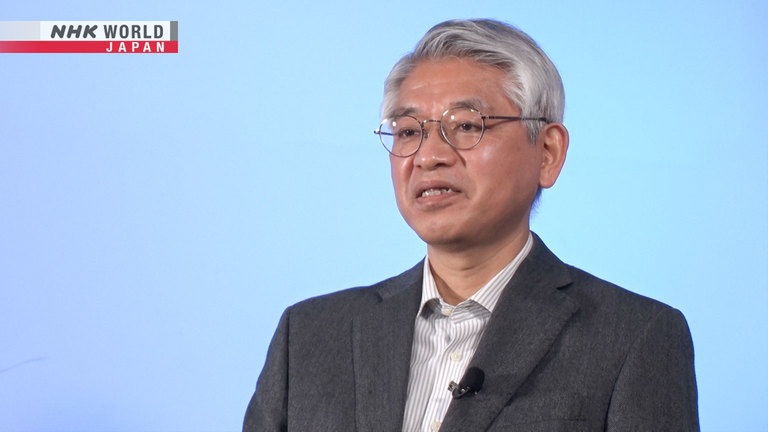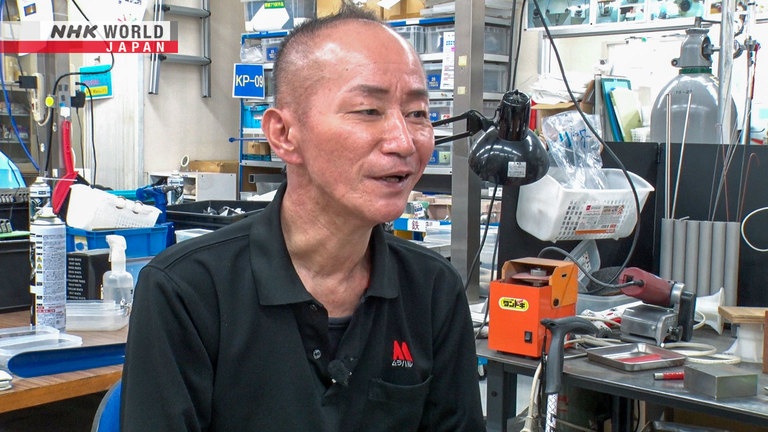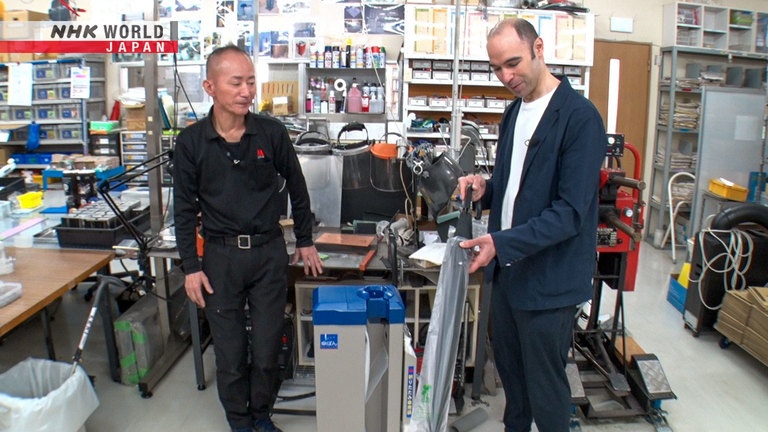Online Karaoke Services / Umbrella Bagging Machines
The fascinating stories and secrets behind hit Japanese products, plus parts and machines that boast the top share of niche markets. In the first half: the story behind online karaoke services which allow the latest songs to be transmitted over the net and sparked a karaoke boom in Japan. In the second half: umbrella bagging machines which allow people to easily cover a wet umbrella with a plastic bag.



Transcript
"Japan's Top Inventions"
The behind-the-scenes tales of hit products and creations from Japan.
This is "Japan's Top Inventions."
On today's show...
singing your favorite songs with karaoke.
We tell the story of a machine
which helped make karaoke bigger than ever in Japan.
Later...
On rainy days, these special devices are placed at entrances.
We'll show you what they're used for.
Hello, welcome to "Japan's Top Inventions."
I'm your host, Jason Danielson.
In the first half of our show, we take you "Behind the Creation."
Today's topic is this.
Karaoke, from Japan.
The latest karaoke machines let you pick songs to sing from a tablet.
You can find anything from classic Japanese ballads to current J POP hits.
There are even songs in English.
New J POP songs get karaoke versions especially quickly,
and more tracks are always being added.
What led to these current karaoke systems
was this machine developed three decades ago.
It was unlike the ones that came before, and sparked a karaoke boom.
The museum of an electronics manufacturer in Nagoya.
On display are products that the company has made over the years.
Among them is this machine from 1992.
This is our first online karaoke machine.
An online karaoke machine.
New songs are downloaded from a server through the phone line.
Tracks can be stored on the internal hard drive and played back.
New songs that were popular with young people
were rapidly made available with this machine.
It was really groundbreaking at the time.
Other companies followed suit, leading to current online services.
Our story begins in 1985.
The news broke that private companies would be allowed to compete
in the formerly government-controlled telecommunications sector.
Businesses would have the chance to use existing networks
to facilitate new means of data transfer.
One of the companies that saw the business potential in this
was a printer and fax machine maker.
As a foray into data transmission,
the company developed this software vending machine.
The device was set up in computer shops.
You inserted your money, selected the game or program you wanted,
and the software would be sent through the phone line.
The data was written onto a floppy disk.
This is Ikami Kazunori,
an engineer who was in his fourth year at the company at the time.
This is what he had heard about the vending machine.
At the peak, there were about 300 machines.
The data was written to a floppy disk on the spot,
so as long as you had a machine running, you could sell software.
One day...
the company received a call.
It was from a business connected with an art college.
"Our students have created audio sequencer versions
of classical music in the public domain.
Could you sell that data with your vending machines?"
Audio sequencer data has numerical values
for all the instruments and notes in a song.
Using special software and a chip
which contains the sounds of various instruments like the piano or guitar,
this music data can be played back as an audio track.
The issue was whether the data could be sent over a phone line.
But the file size was actually much smaller than a real audio recording,
so it wouldn't be an issue.
These data versions of songs were
something like 300 or a 1,000 times smaller.
The files can be very lightweight.
The development team agreed to the business's proposal.
The music data was made available on the vending machines.
But the company found that the music wasn't selling well.
It wasn't a hit like they had hoped.
Was there something else they could do related to music?
The team had an idea.
Commercial karaoke machines found in bars and restaurants.
It was a three-billion-dollar industry.
The machines played songs off large laser discs.
They took up a lot of space,
so there was a limit to how many songs could be offered.
You can fit about 30 tracks total on a laser disc.
There were automatic disc loaders,
but the machines were about the size of a fridge, just really large.
This led the team members
to come up with their concept of an online karaoke service.
New songs would be kept on the company's server.
Using the phone network and their vending machines,
they would deliver music to the local karaoke devices.
The music data would be stored on hard drives,
which meant more songs and less physical space taken up.
And so, the concept for their karaoke service was set.
The team got to work straight away.
The first thing the team did
was buy all the karaoke song catalogues that were available.
They would find the most popular songs between catalogues,
and get permission to create the music data for them.
Their search turned up some 3,000 songs to work on.
Next, they procured the CDs which contained the tracks.
But there was no way they'd be able to create the music data themselves.
So, the team turned to professional musicians for help.
Musicians listened to the CDs,
and wrote down the sheet music for each instrument on each track.
The information from the sheet music would then be entered into the computer.
But there were 3,000 songs with multiple instruments to get through.
It was a dizzying task.
Creating the music data was the most important part.
In order to create the data for 3,000 songs,
we needed strength in numbers.
We had about 100 people working on it together in the end.
It just took plain effort and dedication.
The team made steady progress each day in front of the computers.
One by one, the songs were put together.
Now the team needed to figure out the actual machine
which would be placed in the bars and restaurants.
At the heart would be sound chips capable of reproducing the instruments
in the sequencer data, like piano or guitar.
These were the key components of synthesizers.
Electronic instrument manufacturers made them.
The team made repeated visits to a leading Japanese company in the field,
hoping to secure their help.
It took time but eventually, the company agreed.
The components at the time
lacked some of the instruments we needed for karaoke,
such as the shamisen, a Japanese string instrument.
They were able to add those for us on a custom circuit board.
With that, we had all the pieces ready.
The team was able to secure new sound chips for their machine.
They were one step closer to realizing their concept.
And so, the team had its sights
set on launching their first online karaoke service.
The machine would go from the size of a fridge
down to something that could rest on a table.
But there were still many hurdles to overcome.
The goal was in sight for the team,
but would they be able to compete with existing karaoke products?
They needed to convince the company's management group.
There was no turning back at this point.
A plan was set in motion for their pitch meeting.
The team figured out what songs the management group liked.
Then they picked out songs that were easy to sing and let them try it out.
It went so well that the management group agreed
this would appeal to most people out there.
That this really could work.
So the team got the go ahead.
Finally, in September 1992,
the company's first online karaoke machine was finished.
The team went to sell their product to various drinking establishments.
They pointed out the pros of their online karaoke service.
But not many were convinced.
The reason was immediately apparent.
Most karaoke singers at these pubs were middle-aged or older.
The company hadn't been able to get permission
for many of the older hits that appealed to this particular group of people.
There were a lot of songs that we just couldn't get the rights for.
And they were the ones that were popular at the shops we were targeting.
We heard that customers giving our machines a try would get mad
that their song wasn't on there.
Was there another way to sell their service?
The team looked towards rental karaoke rooms,
which were gaining in popularity.
These were large facilities
which housed many smaller rooms and booths for rental.
They were becoming a hit with younger people.
With this new target in mind,
the developers looked towards adding more songs to their service.
They watched all the music programs they could on TV,
trying to figure out what young people wanted to sing.
Their search came up with 2,000 songs.
After securing the right permissions,
they got to work creating the music data.
The team worked over many days and nights.
After two months, they were able to assemble the 2,000 tracks.
The team had created a machine
that could play from a basic set of 5,000 songs.
The end of 1992.
To celebrate the completion of the new machine,
the staff that worked on the music data gathered to have a party.
They rented out a banquet hall and of course,
brought one of their new karaoke machines.
Everyone had a blast, singing their hearts out.
Despite its small size,
the machine played songs for over four hours with no repeated tracks.
Someone in charge of the banquet hall was watching all this go on.
He tapped one of the team members on the back.
Had they made too much noise?
The team member cautiously turned around.
"Excuse me. Could you sell me this machine?"
Unlike with laser discs, you can get straight to another track.
You really could just keep on singing with our machine.
I hear the man from the banquet hall saw this and asked for one on the spot.
After all that had happened, it was so validating.
That was how the value of the online karaoke service became recognized.
Afterwards, machines were installed at rental karaoke rooms across Japan,
with young people lining up to have a turn.
The online karaoke service led to an unprecedented karaoke boom in Japan.
How do experts view this invention?
We're joined by Yuino Natsumi to learn more.
Welcome to the show.
Thanks for having me.
How did karaoke in Japan
change after the introduction of online karaoke services?
Simply put, the number of songs vastly increased.
Laser disc karaoke required discs to be sent to the shop.
But with online karaoke services,
you can quickly send songs over the net,
like the new ones that young people want.
I believe that shift to a younger market is thanks to online karaoke services.
What kind of significance do you think karaoke holds with Japanese people?
You could say karaoke really suits the character of Japanese people.
Many tend not to assert themselves.
Or they're a bit reserved, and conscious of others.
But when you hold the mic, you're the star.
Karaoke gives people that power, that opportunity.
I think that's part of what really grabbed the Japanese people.
What sorts of advances can we expect with karaoke in the future?
I think there will be features for people who aren't as good at karaoke.
For example, correcting pitch in real time.
An AI would determine what the right pitch is
for what you're trying to sing and automatically adjust in real time.
I think features like this will become possible in the future.
Thank you for your time. It was nice speaking with you.
Thanks for having me.
Top Niche Creations.
Our next segment is "Top Niche Creations."
Today, we're looking at this special box.
Do you know what this is?
It's something that's placed at the entrances of office buildings
and commercial facilities across Japan on a rainy day.
Just what is it for?
We sent our reporter to find out.
Hey everyone, this is Cyrus Nozomu Sethna.
I am here in Sagamihara, Kanagawa Prefecture,
bit of a distance from Tokyo.
Now, why am I here today you ask?
Well, to visit this company over here
to see what they make and how it benefits the people of Japan.
So, let's take a look.
The company specializes in metalworking.
As we approach the entrance...
Would you look at this incredible structure right over here.
We've got what looks like a container of some sort
and what looks like a giant umbrella sticking halfway inside.
It's almost like a surreal art piece
but there is a genuine function to how this thing works.
We asked the creator, Murakami Toshiyuki,
to learn more about what this object is for.
This is our company's main product, but twice the normal size.
It's used for something with wet umbrellas.
- Wet umbrellas?
- Yes.
Here is the actual device.
Murakami shows me how it works.
So it goes in here.
Put it down the hole,
and then pull sideways.
I see. It went right in.
The device is used to put a bag over a wet umbrella.
Insert your umbrella...
pull towards yourself, and your umbrella is bagged.
What's the reasoning behind bagging a wet umbrella?
If the floor of a shop gets wet from the rain,
that becomes a slipping hazard.
Or, books in a bookstore could get wet.
Shops want to avoid these kinds of problems.
Just how does this device get the bag to go on?
We were given the chance to take it apart and find out.
Just like that?
And then this comes out.
I see. So this is what the key component looks like.
Let's take a closer look at this piece.
As the umbrella pushes down,
the piece slides into the mouth of the bag and opens it up.
This mechanism was inspired by a certain something.
So where did the idea come from?
This right here.
- A shoehorn?
- That's right.
I was using one to slip on my shoes one day when it hit me,
that this just might work.
Around 100,000 devices have shipped since they were created in 1994.
They're currently used at offices and shopping centers across Japan.
Development started after Murakami spotted the umbrella bags
at the entrance of a hospital one rainy day.
The rain was pouring, the wind was blowing,
but people were struggling at the entrance to get their umbrellas in a bag.
Was there really no better way?
The world is full of things that people have put effort into improving.
So many things have been made more convenient.
It felt like people were forgetting about the umbrella bags.
Would it be possible to automate the bagging?
Murakami dove into the design process.
The shoehorn had inspired the mechanism for opening the bags,
but it wasn't working well at first.
The opening here is all stuck together, like this.
That's where another idea came in.
I was inspired by this.
An envelope.
There's a height difference between the pocket here and the flap.
Because of this difference, it's easy to slip a finger in, or anything.
It's interesting how you were inspired by all these everyday objects.
There really are hints all around us.
Amazing.
It's been 30 years since the first device.
Now, there are models with a mechanism to quickly remove the umbrella bag...
and ones for collapsible umbrellas.
Devices have even been sold to museums in Europe,
and luxury hotels throughout Asia.
Before leaving, we asked Murakami about what he's working on next.
Are there other things you're thinking about creating?
Yes. I'm thinking of going beyond umbrellas.
Make bagging devices for other things,
devices to enclose other objects.
It would be good to keep expanding into devices like that, I think.
The company is also working on improvements to the bags for the umbrellas.
This is one of their new ones.
In order to reduce CO2 emissions,
the bag uses a 25% blend of bioplastic derived from sugar cane.
It also has a loop to help prevent the bag from slipping off the umbrella
due to the weight of the water accumulating at the bottom.
Who would have thought this little bag had all these features?
That's all for this episode of "Japan's Top Inventions."
We'll leave you with what came next
for the online karaoke service from the first half of the show.
See you next time! And stay inventive.
(It's been 30 years since the company's first online karaoke machine.)
(The newest models allow access to over 340,000 tracks.)
(There are songs in many languages, including English, Korean, and Chinese.)
(Ikami Kazunori helped develop the online karaoke service.)
(It's his first time seeing the original machine in some time.)
We make devices that make people happy.
That's an extremely gratifying job to do.
Karaoke is at the heart of such an enormous industry.
I'm so glad to have been able to contribute to something like that.
I'm very proud of the work that we've accomplished.